EnFuse Solutions is a leading Digital Service provider that offers a wide range of AI/ML Enablement, Proctoring, eCommerce, Data Management, and managed services worldwide.
Don't wanna be here? Send us removal request.
Text
Boost Training Data: The Importance of Annotation Services in AI Models
In the rapidly evolving world of artificial intelligence (AI), the key to creating highly accurate and reliable AI models lies in the quality of training data. The better the training data, the more effective the AI model will be. But raw data alone isn’t enough; it requires structure, context, and meaning to be useful.
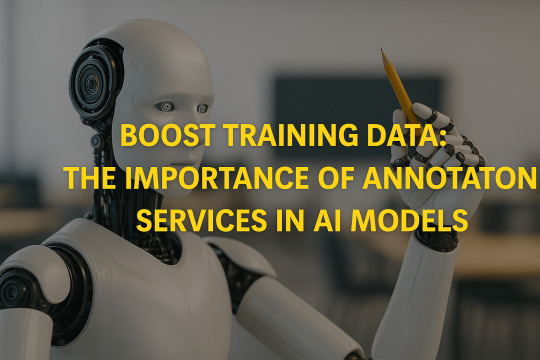
This is where data annotation becomes indispensable. Data annotation plays a critical role in transforming raw data into high-quality labeled datasets that can dramatically boost AI models.
What is Data Annotation?
Data annotation involves tagging or labeling data to ensure it is comprehensible and usable by machine learning algorithms. AI algorithms may learn patterns, correlations, and classifications by using this labelled data, sometimes referred to as training data annotation. With the increasing complexity of AI applications, AI data annotation services have become crucial to achieving model accuracy and efficiency.
Why Annotation Services are Essential for AI Models
1. Enhancing AI Model Accuracy: The primary objective of any AI model is to deliver accurate results. Properly annotated data significantly improves AI model accuracy by ensuring that the machine learning algorithms have clean, organized, and labeled datasets to learn from. This helps the AI systems recognize patterns more efficiently and make better predictions.
2. Improving Training Data Quality: Raw data is typically unstructured and inconsistent. By using AI annotation solutions, you can convert this raw data into valuable information that AI models can process. AI training data services provide high-quality, consistent, and accurately labeled datasets that help machines learn effectively. This enhances the quality of the training data for AI, leading to more precise outputs.
3. Boost AI Models with Comprehensive Annotations: From text to images, and even video, different types of data require different approaches to annotation. AI annotation solutions ensure that each piece of data is labeled appropriately for the specific AI application. Whether it’s categorizing images, tagging objects in videos, or labeling text, these services provide a wide range of annotations that can boost AI models in various sectors, including healthcare, autonomous driving, retail, and more.
Types of Annotation Services for AI
Several types of annotation services cater to the diverse needs of AI models:
Text Annotation: Labeling sentences, keywords, and phrases to help natural language processing (NLP) systems understand the context.
Image Annotation: Labeling objects or regions within images to train models for object recognition, detection, and segmentation tasks.
Video Annotation: Tagging frames and objects within videos to help in the development of models for autonomous vehicles, security systems, and more.
Leading service providers like EnFuse Solutions offer tailored data annotation services in India and across the globe, leveraging local expertise and AI-driven tools to deliver exceptional results for clients.
Data Annotation Services: A Game-Changer for AI Training
With the increasing reliance on AI in various industries, the demand for high-quality training data is skyrocketing. Using advanced annotation services, AI can significantly impact an organization's ability to develop reliable AI models.
Here's why you should consider AI data labeling services for your business:
Scalability: Your data expands along with your business. Data annotation services allow you to scale your AI training efforts by offering flexible, on-demand annotation solutions that keep pace with your evolving needs.
Cost-Effectiveness: Outsourcing to expert providers in regions like India can reduce costs while maintaining high-quality standards. Data annotation services in India combine affordability with skill, making it a popular choice for companies worldwide.
Expertise: Companies offering AI annotation solutions bring in specialized knowledge in handling different types of data, ensuring accuracy and consistency in annotations.
EnFuse Solutions: Your Partner in Data Annotation for AI
At EnFuse Solutions, we recognise that accurate AI model development depends on providing high-quality AI training data services. We provide comprehensive annotation for machine learning services, tailored to meet your specific AI application needs. With years of experience and a dedicated team of experts, we offer scalable, efficient, and cost-effective data annotation services in India and globally.
Our services ensure that your AI models are trained on the most reliable data, improving accuracy, performance, and efficiency. Whether you're working on image recognition, NLP, or any other AI application, EnFuse Solutions can help you unlock the full potential of your AI models through exceptional AI data annotation services.
Conclusion
In the competitive world of AI, precise data annotation is the key to unlocking the full potential of AI models. High-quality AI data annotation significantly boosts AI model performance, enhances accuracy, and supports advanced applications. To stay ahead, businesses must invest in reliable AI training data services, and EnFuse Solutions is here to help.
AI models that are dependable and efficient may be developed more quickly by concentrating on high-quality training data for AI. With the right annotation services, you can ensure your models deliver the best results, driving success in your AI projects. Contact EnFuse Solutions today to empower your AI models with expert annotation services.
#DataAnnotation#AIDataAnnotation#TrainingDataAnnotation#AnnotationServicesAI#BoostAIModels#AITrainingDataServices#DataAnnotationForAI#AIModelAccuracy#TrainingDataForAI#AIAnnotationSolutions#AIDataLabeling#AnnotationForMachineLearning#DataAnnotationServicesInIndia#EnFuseSolutions
0 notes
Text
How to Use Schema Markup for Better SEO Results
In today’s competitive digital landscape, achieving top rankings in search engine results pages (SERPs) is crucial for driving traffic and enhancing visibility. One highly effective strategy for improving search engine optimization (SEO) is the use of Schema Markup SEO. Through the use of structured data SEO, websites can provide search engines with comprehensive details about their content, enabling them to deliver richer, more informative search results.

In this schema markup guide, we’ll explore how to improve search engine optimization (SEO) with schema, enhance visibility, and drive better rankings.
What is Schema Markup?
Schema markup is a type of structured data that enables search engines such as Google, Bing, and Yahoo to interpret your website's content more precisely. By adding schema code for SEO, webmasters can present detailed information in a way that search engines can easily process. This enhanced understanding allows search engines to display rich snippets SEO—detailed search results that often include additional features like images, ratings, or prices.
Why is Schema Markup Important for SEO?
Using schema for SEO is essential because it allows you to communicate directly with search engines. By implementing structured data for ranking, you’re essentially telling search engines exactly what your page is about, which can lead to more accurate and enhanced visibility in the SERPs. Websites that use schema markup are more likely to achieve rich snippets, which have higher click-through rates compared to regular listings.
The Benefits of Schema Markup for SEO
1. Rich Snippets SEO: Schema markup increases the chances of your content being displayed as rich snippets. These enhanced results include visual elements like images, reviews, and additional information, making your listing stand out in the search results.
2. Improved Click-Through Rates (CTR): Rich snippet listings can attract more clicks because of their increased level of information and engagement. As a result of this, organic traffic may rise significantly.
3. Increased Ranking Potential: While SEO schema integration itself is not a direct ranking factor, it helps search engines understand your content better, which may indirectly contribute to higher rankings.
4. Better Local SEO: Companies with physical storefronts can boost their visibility in local search results by using local business schema. This is crucial for enhancing visibility in geo-targeted searches.
How to Implement Schema Markup for SEO
1. Identify Key Pages for Schema: Start by determining which pages on your website will benefit most from schema markup. These could be product pages, blog posts, service offerings, or event listings.
2. Choose the Right Schema Type: There are numerous schema types available, ranging from articles, FAQs, products, and events to local businesses. Select the schema that best captures the information on your page.
3. Use Google’s Structured Data Markup Helper: Google offers a user-friendly tool that helps you generate schema code for SEO. Once you’ve selected your schema type, tag the elements on your page, and the tool will create the necessary markup.
4. Test and Validate Your Markup: Before implementing the schema on your website, use Google’s Rich Results Test to ensure the code is correct. This tool will help you verify that your schema is properly formatted and eligible for rich snippets.
5. Update and Monitor: Regularly update your schema to align with changes in your content and Google’s evolving SEO best practices. Consistently monitor your search performance using tools like Google Search Console to track the impact of your schema SEO strategy.
Schema SEO Best Practices
Consistency: Make sure your website's structured data appropriately represents the information on your page. Providing false information might lead to fines or decreased visibility.
Stay Updated: Schema.org updates its list of supported schema types regularly. Staying informed on these updates will help you adapt your SEO strategy effectively.
Hire SEO Services: If you find schema markup implementation complex, consider hiring SEO services from trusted experts like EnFuse Solutions India. Their expertise can ensure accurate and impactful schema integration.
Conclusion
Incorporating schema markup SEO into your digital strategy can significantly improve your search visibility, helping your content stand out with rich snippets SEO. By following this Schema SEO strategy and adhering to Schema SEO best practices, you can effectively boost SEO with schema, enhance user engagement, and drive more organic traffic.
Whether you're a small business or a large enterprise, structured data is a powerful tool for enhancing your online presence and improving SEO with schema. Let EnFuse Digital House help you integrate schema and take your digital strategy to the next level. By utilizing schema markup correctly and partnering with EnFuse Solutions India, you can optimize your website’s performance, achieve higher rankings, and outperform competitors in the SERPs.
#Schema Markup SEO#Structured Data SEO#SEO Schema Integration#Schema For SEO#Rich Snippets SEO#Schema SEO Strategy#Improve SEO With Schema#Schema Markup Guide#Boost SEO With Schema#Schema Code For SEO#Schema SEO Best Practices#Structured Data For Ranking#SEO Services#EnFuse Digital House#EnFuse Solutions India
0 notes
Text
Product Data Management Vs PIM: What’s the Difference and Which Do You Need?
In today’s competitive marketplace, efficiently managing product data is crucial to business success. Whether you’re an e-commerce platform, a manufacturer, or a retailer, accurate and well-organized product data can significantly impact your bottom line. Two powerful solutions for managing this data are Product Data Management (PDM) and Product Information Management (PIM). But what are the differences between these systems, and which one is best for your company?
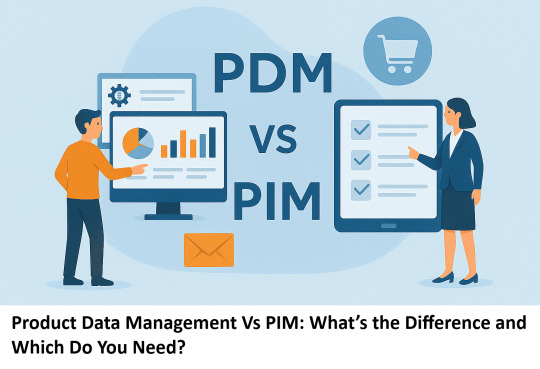
Here, we’ll break down the difference between PIM and PDM and guide you on how to make a decision.
What is Product Data Management (PDM)?
Product Data Management is mainly utilized by engineering and manufacturing firms to organize and control technical data associated with product development. PDM systems handle data such as design documents, CAD files, BOMs (Bill of Materials), and specifications necessary for production and R&D processes. A PDM system ensures version control, access rights, and collaboration among engineering teams.
Key Benefits of PDM:
Centralized Data Storage: All product data is stored in a single location, ensuring that teams can access accurate information.
Improved Collaboration: PDM enables collaboration across different departments, reducing time spent on data retrieval.
Version Control: Ensures that engineers and designers are working with the latest product data.
For businesses in engineering or product manufacturing, PDM tools like SolidWorks PDM or Siemens Teamcenter are essential for managing complex data and enhancing workflow efficiency.
What is Product Information Management (PIM)?
Conversely, Product Information Management (PIM) is centred around handling product data related to marketing, sales, and distribution. A PIM system centralizes product information, such as descriptions, pricing, images, and specifications, to ensure consistency across various sales channels. It is crucial for businesses that need to deliver accurate, up-to-date product data to customers, especially in the e-commerce and retail sectors.
PIM System Benefits:
Omnichannel Consistency: PIM helps businesses ensure consistent product information across all channels—whether it's online marketplaces, physical stores, or catalogs.
Efficient Data Management: Centralizing product data in a PIM system reduces manual errors and speeds up the process of updating product information.
Enhanced Customer Experience: Accurate and consistent product data leads to better customer experiences, improving conversions and reducing returns.
Popular PIM systems include Akeneo, Salsify, and Pimcore, which provide robust solutions for managing product data at scale.
PIM Vs Product Data Management (PDM Vs PIM Explained)
With a clear understanding of what PIM and PDM systems entail, let's explore the PIM vs. PDM difference. While both systems handle product data, their purposes and functionalities are different:
Technical and engineering data management is best served by PDM, which guarantees efficient product development procedures.
PIM is best for managing marketing and sales data, ensuring accurate product information is delivered to customers across channels.
But if your business focuses on product development and manufacturing, a PDM system is essential. But if you're dealing with product information across multiple sales channels, a PIM system is a better choice.
Key Differences Between PIM and PDM Systems
Understanding the difference between PIM and PDM is essential for choosing the right system based on your business needs.
1. Purpose:
PDM is concerned with managing technical data associated with product development, such as CAD files and engineering specs.
PIM manages non-technical product data used in marketing and sales, like descriptions, images, and prices.
2. Target Audience:
PDM is used mainly by engineering and product development teams.
PIM is used by marketing, sales, and e-commerce teams.
3. Data Types:
PDM handles design documents and technical specifications.
PIM manages marketing content, product attributes, and customer-facing data.
4. Use Cases:
PDM is critical for companies focused on product design and manufacturing.
PIM is ideal for businesses looking to streamline product information across multiple sales channels.
Which Do You Need: PIM or Product Management?
Choosing between PIM and PDM depends on your business needs. If your focus is on creating and developing products, you’ll benefit from a Product Data Management system that handles technical files, revisions, and collaborative workflows. Conversely, if your business is in e-commerce or retail, where consistent product information across channels is critical, a Product Information Management solution is the right fit.
For companies that need both, integrating PIM and PDM systems can provide a comprehensive solution for managing product data throughout its lifecycle—from development to customer-facing information.
Conclusion
Understanding the difference between PIM and PDM is crucial for businesses looking to optimize their product data processes. Whether you’re managing technical data or customer-facing information, choosing the right system can enhance efficiency and drive business success. Let EnFuse Solutions guide you in selecting and implementing the best solution for your product data needs, ensuring long-term growth and success.
By using this strategic guide, your business can make informed decisions about implementing the right product data solution, driving efficiency, and enhancing the customer experience across all platforms.
#ProductDataManagement#PIMVsProductManagement#DifferenceBetweenPIMandPDM#ProductInformationManagement#PIMSystemBenefits#ProductDataSolutions#PIMorProductManagement#PDMVsPIMExplained#ChoosingPIMorPDM#ProductDataManagementTools#PIMVsPDMSystem#ProductDataManagementServices#EnFuseSolutionsIndia
0 notes
Text
AEM Forms: Streamlining Document Management with Adobe Experience Manager
Managing documents efficiently has become essential for organizations across all sectors in the fast-paced digital landscape. Adobe Experience Manager (AEM) Forms provides a robust solution to streamline document workflows, enhance customer experiences, and boost overall operational efficiency. Whether you are looking for AEM services to automate form processing or integrate digital forms into your systems, AEM Forms is a game-changer for organizations of all sizes.
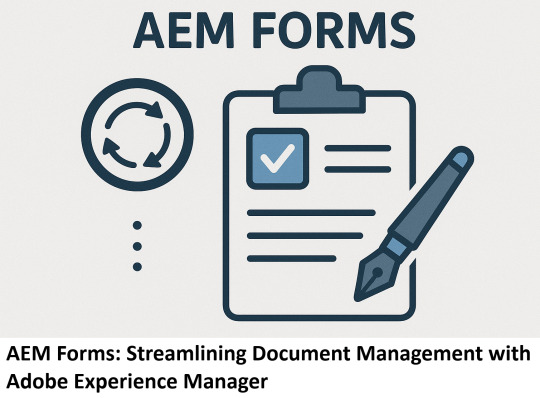
Let’s dive into how AEM Forms can simplify document management and explore its benefits.
What is AEM Forms?
AEM Forms is a powerful component of Adobe Experience Manager, enabling businesses to create, manage, and distribute digital forms effortlessly. The platform offers a variety of features that facilitate the automation of document processes and integrate seamlessly with existing systems. Whether it’s collecting customer data, processing applications, or managing digital signatures, AEM Forms can handle it all.
By leveraging AEM Forms integration, organizations can automate repetitive tasks, reduce human error, and improve the overall efficiency of their document management systems. It provides a complete suite of solutions for those looking to streamline document workflows and manage forms in a secure, scalable manner.
AEM Forms Features That Elevate Document Management
1. AEM Forms Automation: AEM Forms enables the automation of manual processes, reducing the time and effort involved in document management. Automated workflows help organizations manage high volumes of forms efficiently, enhancing productivity.
2. AEM Forms Templates: Customizable templates allow organizations to create consistent and branded forms across all channels. This eliminates the need for repetitive design work, ensuring a professional and uniform presentation.
3. AEM Digital Forms: AEM Forms allow users to generate responsive, dynamic digital forms that are easy to use. These forms adapt to various devices and platforms, ensuring a seamless experience for end users.
4. AEM Document Processing: The document processing capabilities of AEM Forms include advanced data capture and analysis. This feature allows businesses to collect and store data more efficiently, improving decision-making and operational workflows.
5. AEM Forms Solutions: AEM Forms offers a range of solutions for industries such as banking, insurance, healthcare, and government. These tailored solutions help organizations meet their specific regulatory and operational requirements.
6. Adobe Document Management: AEM Forms enhances Adobe’s document management capabilities, allowing users to securely store, organize, and access digital documents. This ensures compliance and security in sensitive operations.
7. AEM Forms Integration: AEM Forms can seamlessly integrate with other Adobe services and third-party applications. This flexibility allows organizations to enhance their existing infrastructure without disrupting their workflows.
How AEM Forms Streamlines Document Workflows?
AEM Forms provides several tools and features that allow businesses to streamline document workflows effectively:
Enhanced Efficiency: The automation of document management processes helps organizations reduce time-consuming manual tasks. From data capture to document storage, AEM Forms makes document management smoother and more efficient.
Better User Experience: AEM Digital Forms are designed with the end-user in mind, providing an intuitive and seamless experience. Whether on a desktop or mobile device, users can easily fill out and submit forms without hassle.
Scalability and Security: AEM Forms is favourably scalable, making it convenient for businesses of all sizes. Its robust security features protect sensitive data throughout the document management lifecycle.
Cost Reduction: By automating and digitizing forms, AEM Forms helps organizations reduce paper usage, printing costs, and the overhead associated with manual document processing.
Why Choose AEM Forms for Your Business?
Adobe Experience Manager Forms empowers businesses to automate document workflows, enhance customer engagement, and minimize operational inefficiencies. With Adobe Forms Management, organizations can digitize paperwork and automate complex processes, ultimately leading to significant time and cost savings.
Whether you’re a global enterprise or a small business, AEM Forms Solutions can be tailored to your specific needs. The flexibility and scalability of AEM Services ensure that companies can adopt solutions as per their document management and form-processing requirements.
EnFuse Solutions: The Best AEM Services in India
If you are looking for the best AEM Services in India, EnFuse Solutions offers unparalleled expertise in AEM services. With a focus on delivering customized solutions, EnFuse helps businesses maximize the potential of Adobe Experience Manager Forms, ensuring seamless document management and enhanced customer experiences.
Conclusion
AEM Forms provides a comprehensive suite of tools to simplify, automate, and enhance document workflows, making it an essential platform for businesses aiming to optimize their digital processes. Partner with EnFuse Solutions to leverage the full potential of AEM Forms and transform your document management systems for the better.
By optimizing your organization’s document management processes with AEM Forms, you unlock a new level of efficiency, all while improving customer satisfaction.
#AEMServices#AEMFormsIntegration#AdobeDocumentManagement#AEMFormsAutomation#StreamlineDocumentWorkflows#AEMFormsTemplates#AEMDigitalForms#AdobeExperienceManagerForms#AEMFormsSolutions#AEMDocumentProcessing#AdobeFormsManagement#AEMFormsFeatures#BestAEMServicesInIndia#EnFuseSolutions
0 notes
Text
Integrating Adobe Experience Manager Services with Other Adobe Marketing Cloud Solutions
In today’s digital landscape, delivering personalized and seamless customer experiences is a top priority for businesses. Adobe Experience Manager (AEM) is a powerful content management solution that enables organizations to create, manage, and optimize digital experiences across various channels. When integrated with other Adobe Marketing Cloud solutions, AEM can significantly enhance an organization’s marketing capabilities, providing a unified platform for content, data, and insights.
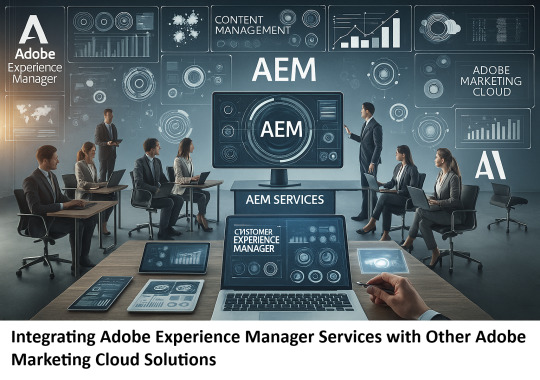
Let’s explore how integrating Adobe Experience Manager (AEM) with Adobe Marketing Cloud solutions can help you unlock the full potential of your digital marketing strategy.
Understanding Adobe Experience Manager Integration
Adobe Experience Manager integration with other Adobe Marketing Cloud solutions enables businesses to provide unified and personalized customer experiences. By combining the power of AEM with tools like Adobe Analytics, Adobe Campaign, Adobe Target, and Adobe Commerce, organizations can streamline their marketing efforts, drive customer engagement, and improve ROI.
AEM and Adobe Marketing Cloud Integration: A Methodical Approach
Integrating AEM with the Adobe Marketing Cloud provides a holistic approach to managing and optimizing customer experiences. Let's examine a few significant integrations in more detail:
1. Integrating AEM with Adobe Analytics: Adobe Analytics gives strong data and insights, enabling marketers to gain a more in-depth understanding of customer behavior and choices. By integrating AEM with Adobe Analytics, businesses can leverage data-driven insights to personalize content and enhance user experiences. This integration enables real-time tracking and analysis of user interactions, allowing marketers to make informed decisions and optimize their content strategies effectively.
2. AEM and Adobe Campaign Integration: Adobe Campaign enables marketers to design and automate customer journeys across multiple channels. When integrated with AEM, Adobe Campaign allows for the seamless delivery of personalized content and campaigns based on user behaviour and preferences. This integration ensures that the right message reaches the right audience at the right time, increasing engagement and conversion rates.
3. Adobe Experience Manager with Adobe Target: Adobe Target is a powerful tool developed for testing and boosting digital experiences. Integrating AEM with Adobe Target enables businesses to deliver personalized content and experiences based on user behaviour and preferences. This integration allows for real-time testing and personalization, ensuring that each user receives a tailored experience that aligns with their needs and interests.
4. Adobe Experience Manager and Adobe Commerce: For businesses with an e-commerce presence, integrating AEM with Adobe Commerce is crucial for delivering a seamless shopping experience. This integration allows businesses to effectively manage and enhance product content, tailor shopping experiences to individual customers, and simplify the customer journey from the initial discovery to the final purchase. By leveraging the combined power of AEM and Adobe Commerce, businesses can drive higher conversion rates and increase customer loyalty.
AEM Integration Best Practices
To maximize the benefits of integrating Adobe Experience Manager with other Adobe Marketing Cloud solutions, it’s essential to follow the best practices:
1. Plan and Strategize: Begin by understanding your business objectives and identifying the key integrations that will help you achieve them. Develop a comprehensive integration strategy that aligns with your marketing goals.
2. Ensure Data Consistency: Maintain data consistency across all integrated platforms to ensure a unified view of the customer journey. This helps in delivering personalized experiences and enhances decision-making.
3. Leverage Automation: Automate workflows and processes wherever possible to improve efficiency and reduce manual efforts. This includes automating content delivery, data synchronization, and campaign management.
4. Test and Optimize: Regularly test and optimize your integrations to ensure they are functioning as expected. Use tools like Adobe Target to experiment with different content variations and personalization strategies.
Choosing the Best AEM Services
When it comes to implementing Adobe Experience Manager and integrating it with other Adobe Marketing Cloud solutions, partnering with a reliable service provider is crucial. EnFuse Solutions India offers comprehensive AEM services that include consulting, implementation, and support. EnFuse Solutions combines a team of skilled professionals with a focus on customer needs to ensure your AEM integration is smooth and tailored to your business objectives.
Conclusion
Integrating Adobe Experience Manager with other Adobe Marketing Cloud solutions is a strategic move that can significantly enhance your digital marketing capabilities. By leveraging the power of AEM alongside tools like Adobe Analytics, Adobe Campaign, Adobe Target, and Adobe Commerce, businesses can deliver personalized and seamless customer experiences that drive engagement and conversion. Follow best practices and partner with a trusted service provider like EnFuse Solutions India to maximize the benefits of your AEM integration and achieve your marketing goals.
By adopting a comprehensive and strategic approach to Adobe Experience Manager integration, businesses can stay ahead of the competition and deliver exceptional customer experiences across all touchpoints.
#AdobeExperienceManagerIntegration#AEMAndAdobeMarketingCloudIntegration#IntegratingAEMwithAdobeAnalytics#AEMandAdobeCampaignIntegration#AdobeExperienceManagerwithAdobeTarget#AdobeMarketingCloudSolutions#AEMIntegrationBestPractices#AdobeExperienceManagerandAdobeCommerce#BestAEMServices#EnFuseSolutionsIndia
0 notes
Text
AEM Best Practices: Ensuring a Seamless Migration and Implementation
Migrating to Adobe Experience Manager (AEM) can be transformative for businesses looking to enhance their digital experience capabilities. However, this transition can be fraught with challenges without the right strategies and preparation.

This blog provides an in-depth look at AEM migration best practices and offers a seamless AEM implementation guide to ensure a smooth journey.
Understanding AEM Migration: Why It Matters
Adobe Experience Manager is a powerful content management system (CMS) that combines digital asset management with the power to deliver personalized, omnichannel experiences. Migrating to AEM requires careful planning and execution, but the benefits, such as streamlined content management, enhanced user experiences, and robust performance, make it worthwhile.
Key Adobe Experience Manager Migration Tips
1. Conduct a Comprehensive Audit: Start by auditing your current content and infrastructure to identify valuable assets and remove redundant, outdated, or trivial (ROT) ones. This helps in understanding your existing site architecture and planning the new AEM structure effectively.
2. Define Clear Objectives and Goals: Establish specific, measurable goals for AEM, such as improving site performance or enhancing user experience. Clear objectives will guide your migration strategy and align with your business goals.
3. Develop a Detailed Migration Plan: Create a thorough migration plan outlining each phase, from content analysis and template creation to component development and testing. Include timelines, resource allocation, and risk management to ensure a smooth transition.
Best Practices for AEM Migration
To ensure a successful AEM migration, follow best practices to mitigate risks and optimize the process:
Content and Component Mapping: Map existing content types and components to AEM’s structures to avoid data loss or corruption and ensure accurate migration.
Optimize Content Before Migration: Clean up and streamline content to include only valuable assets, reducing workload and speeding up the migration.
Leverage AEM’s Built-In Features: Use AEM’s native functionalities rather than custom solutions to cut development time and ensure smoother future updates.
Addressing AEM Migration Challenges and Solutions
Despite the best planning, challenges may arise during AEM migration. Let's look at these common challenges and their solutions:
Data Integrity Issues: Ensure data consistency and integrity by using robust migration tools and thoroughly testing the migrated content. Conducting regular data validation checks throughout the migration process can help identify and resolve issues early.
Performance Optimization: Post-migration, it's crucial to optimize your AEM environment for performance. This involves setting up caching systems, optimizing server resources, and tracking performance metrics to detect and address any bottlenecks.
Security Concerns: Migration involves moving sensitive data, which must be protected. Implement strong security measures, such as encryption and access controls, to safeguard your data during migration.
The AEM Implementation Checklist
An AEM implementation checklist is essential for tracking progress and ensuring that all aspects of the migration are covered. A must-include item on your checklist:
Pre-Migration Assessment: Complete a detailed analysis of your current environment and identify migration requirements.
Development and Customization: Customize templates and components to meet your specific needs while leveraging AEM’s core functionalities.
Testing and Validation: Conduct comprehensive testing to ensure that all content, functionalities, and integrations work seamlessly post-migration.
Go-Live Preparation: Prepare a go-live strategy that includes user training, content freeze plans, and a rollback plan in case of any issues.
Crafting Successful AEM Migration Strategies
Developing a Successful AEM migration strategy involves meticulous planning and execution. Here are some strategies to consider:
Phased Approach: Use a phased approach instead of migrating everything at once. This allows you to address any issues in smaller, manageable segments.
Regular Backups: Ensure regular backups are taken throughout the migration process. This protects your data in case of unexpected failures.
Training and Support: Equip your team with the necessary training and support to handle the new system. A well-trained team can significantly reduce the post-migration adjustment period.
AEM Deployment Best Practices
Deploying AEM requires a different set of strategies. Here are some Best Practices for AEM migration to ensure a successful deployment:
Environment Setup: Set up different environments for development, testing, and production. This segregation helps in identifying issues early and ensures a smoother transition to the live environment.
Automated Deployments: Use automation tools to streamline the deployment process. This reduces human error and speeds up the deployment cycle.
Monitor and Optimize: Continuously monitor the system’s performance post-deployment. Use AEM’s built-in tools to identify bottlenecks and optimize accordingly.
Why Choose EnFuse Solutions for AEM Implementation?
For businesses seeking the best AEM implementation services in India, EnFuse Solutions offers unparalleled expertise and experience. Our team of certified AEM experts follows industry best practices to deliver customized, efficient, and reliable AEM solutions tailored to your unique needs. Whether you are migrating from another platform or implementing AEM for the first time, EnFuse Solutions ensures a seamless transition and a successful deployment.
Conclusion
A successful AEM migration and implementation demands meticulous planning, extensive testing, and strict adherence to best practices. By following the Adobe Experience Manager migration tips and solutions outlined in this guide, organizations can overcome migration challenges and achieve a smooth, efficient, and effective AEM deployment. With the right partner like EnFuse Solutions, you can ensure that your AEM implementation is not just successful but transformative for your digital presence.
#AEMMigrationBestPractices#SeamlessAEMImplementationGuide#AdobeExperienceManagerMigrationTips#BestPracticesForAEMMigration#AEMImplementationChecklist#SuccessfulAEMMigrationStrategies#AEMMigrationChallengesAndSolutions#AEMDeploymentBestPractices#BestAEMImplementationServicesInIndia#EnFuseSolutions
0 notes
Text
The Psychology of SEO: Understanding User Intent
In the rapidly changing world of digital marketing, one idea stands above the rest: user intent. Understanding the psychology behind user intent is crucial for any business aiming to rank high on search engine results pages (SERPs). With increasingly sophisticated search engines, it's no longer enough to just pepper your content with keywords. You need to align your SEO strategy with your audience's deeper motivations and desires.
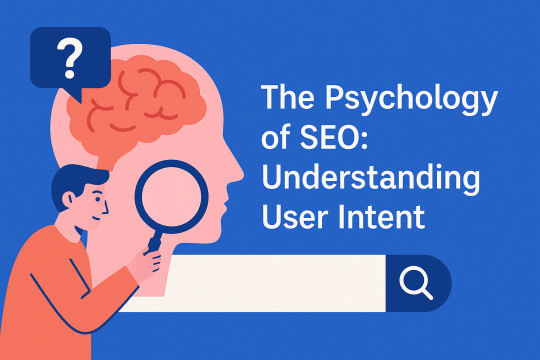
This blog will explore the psychology of user intent in SEO and how a user-focused approach can elevate your digital marketing efforts.
What is User Intent in SEO?
User intent, often called search intent, is the underlying purpose driving a user's search query. It explains the motivation behind what they are searching for. Understanding user intent in SEO means identifying whether the user is looking for information, planning to make a purchase, or trying to reach a particular website.
Search intent in digital marketing is typically categorized into four types:
1. Informational Intent: The user is looking for information. Examples include "How to explain user intent within an SEO framework?" or "What are the best practices for optimizing based on user intent?"
2. Navigational Intent: The user is trying to find a particular website or page, such as “EnFuse Digital House” or “Best SEO company in India.”
3. Transactional Intent: The user intends to make a purchase or complete a specific action, like “buy SEO tools” or “hire EnFuse Solutions India.”
4. Commercial Investigation Intent: The user is researching products or services before making a decision, such as “best SEO strategies” or “top SEO companies in India.”
The Psychology of User Intent
Understanding the psychology of user intent means recognizing that every search query represents a need or desire. Users are not just looking for keywords—they're looking for solutions. By tapping into this psychology, businesses can create content that directly addresses these needs, thereby increasing engagement and conversions.
Behavioural SEO techniques are essential in this regard. They involve analyzing user behaviour on your site to better understand their intent. For example, heatmaps can show where users are clicking, while session recordings can reveal how they interact with your content. This data can be invaluable for refining your user intent SEO strategy.
Search Intent Optimization: A Key to Success
Search intent optimization is the process of tailoring your content to meet the specific needs of users based on their search intent. This goes beyond simply matching keywords; it’s about ensuring that your content satisfies the user’s purpose in visiting your site.
One effective approach is to structure your content in a way that addresses the different types of user intent. For instance, if your target keyword is “User Intent SEO Strategy,” consider creating content that includes a detailed guide (informational), links to your services (navigational), a call to action for a free consultation (transactional), and comparisons or reviews of different strategies (commercial investigation).
SEO and User Behavior: Key Points
1. Intent Alignment: Effective SEO aligns with user intent, ensuring content meets expectations and drives engagement.
2. Behavioural Insights: Analyzing user behavior through tools like heatmaps helps refine SEO strategies for better results.
3. User Experience: Prioritizing a seamless user experience improves site metrics like bounce rate and boosts search rankings.
4. Content Relevance: Creating relevant, high-quality content keeps users engaged and enhances SEO performance.
5. Mobile Optimization: Understanding and optimizing for mobile user behavior is critical for maintaining strong search rankings.
Integrating User Intent into Your Content Strategy
A robust user intent and content strategy is essential for any business looking to succeed in today’s competitive digital market. Intent-based SEO should be at the core of your content creation process. Start by conducting thorough keyword research to identify the different types of intent associated with your target keywords. Next, create content that aligns with these intents, ensuring that it provides real value to your audience.
The best SEO companies understand the importance of aligning content with user intent. For example, at EnFuse Solutions India, we prioritize understanding our clients' target audiences to create tailored strategies that resonate with their specific needs. By focusing on user intent, we help businesses not only rank higher in SERPs but also connect more deeply with their customers.
Conclusion
The psychology of user intent in SEO is a powerful tool for any business looking to thrive in the digital age. By understanding and optimizing for user intent, you can create content that meets the needs of your audience, driving more traffic, engagement, and conversions. Whether you’re just starting or looking to refine your SEO strategy, remember that the key to success lies in understanding your users and catering to their intent.
At EnFuse Solutions India, we specialize in intent-based SEO strategies that deliver results. As the best SEO company in India, we are committed to helping businesses like yours navigate the complexities of SEO and achieve their digital marketing goals. If you’re ready to take your SEO to the next level, get in touch with EnFuse Solutions today!
#UserIntentInSEO#PsychologyOfUserIntent#SEOAndUserBehavior#SearchIntentOptimization#UserIntentSEOStrategy#BehavioralSEOTechniques#SearchIntentInDigitalMarketing#UserIntentAndContentStrategy#IntentBasedSEO#BestSEOCompanyInIndia#EnFuseDigitalHouse#EnFuseSolutionsIndia
0 notes
Text
Data Annotation: The Backbone of AI Training Data Quality
In the fast-paced realm of Artificial Intelligence (AI), the significance of high-quality data is immense. The success of AI models depends significantly on the accuracy and precision of the data used for their training. This is where data annotation for AI plays a critical role. It is the backbone of AI training data quality, ensuring that AI systems are well-equipped to perform tasks accurately and efficiently.

Understanding Data Annotation
Data annotation involves assigning labels to various data types—such as text, images, audio, or video—enabling AI models to identify and learn from the information. These labels help AI systems understand input data, which is crucial for tasks like image recognition, natural language processing, and autonomous driving. Training data annotation is fundamental to creating datasets that AI can learn from, making the process integral to developing AI systems with high precision.
The Importance of Data Annotation in AI
The value of data annotation services for AI is immense and cannot be overlooked. High-quality data annotation ensures that AI models are trained on accurate and relevant data, which directly impacts their performance. Inaccurate annotations can result in erroneous predictions, decreased efficiency, and possible biases within AI systems. Therefore, AI data labeling must be done meticulously to ensure that the AI models can deliver reliable and consistent results.
Best Practices for High-Quality Data Annotation
Delivering accurate AI training data requires adhering to these distinct best practices in data annotation:
1. Consistency: Consistency in labeling is vital for maintaining the integrity of training data. Annotators must stick to a standardized procedure to ensure the data is labeled consistently throughout the dataset.
2. Clear Guidelines: Providing annotators with clear and concise guidelines is essential. This aids in aligning all team members and reduces the possibility of errors.
3. Quality Control: It is necessary to establish a rigid quality control process. This can include double-checking annotations, using automated tools for validation, and conducting periodic reviews to maintain AI data quality management.
4. Use of Advanced Tools: Utilizing cutting-edge annotation tools can significantly boost the efficiency and precision of the annotation process. These tools can automate repetitive tasks and provide annotators with real-time feedback, contributing to high-quality data annotation.
5. Expert Annotators: Utilizing skilled annotators who understand the nuances of the data and the requirements of the AI models can significantly improve the quality of the annotations. Expert annotators can identify subtle patterns and ensure that the data is labeled with high precision.
The Role of EnFuse Solutions India in AI Data Annotation
When it comes to data annotation services, EnFuse Solutions India stands out as a leader in the industry. With a team of expert annotators and a commitment to delivering high-quality results, EnFuse Solutions ensures that your AI models are trained on the most accurate and relevant data. The company’s focus on AI data quality management ensures that the datasets are not only accurately annotated but also optimized for performance.
EnFuse Solutions India adheres to industry-leading data annotation best practices to guarantee the highest quality AI training data. Their services are tailored to meet the specific needs of each client, ensuring that the annotated data aligns perfectly with the goals of the AI project. With a strong emphasis on quality, consistency, and efficiency, EnFuse Solutions India is the go-to partner for companies looking to enhance their AI models with superior training data.
Conclusion
The importance of data annotation in AI cannot be overlooked. It is the cornerstone of effective AI model training and directly influences the success of AI systems. By adhering to best practices and utilizing professional data annotation services, businesses can ensure that their AI models are equipped with accurate AI training data, leading to better performance and more reliable outcomes.
EnFuse Solutions India, with its expertise in data annotation services for AI, is your trusted partner in achieving high-quality AI training data that drives success in the AI-driven world.
#DataAnnotationForAI#AITrainingDataQuality#HighQualityDataAnnotation#DataAnnotationServicesForAI#ImportanceOfDataAnnotationInAI#TrainingDataAnnotation#AIDataLabeling#DataAnnotationBestPractices#AccurateAITrainingData#AIDataQualityManagement#DataAnnotationServices#EnFuseSolutionsIndia
0 notes
Text
Unlock Your eCommerce Potential: The Role of Catalog Management Services
In the dynamic world of eCommerce, staying ahead of the competition requires more than just a great product; it demands impeccable organization, presentation, and management of your online catalog. Effective catalog management is the backbone of any successful eCommerce business, ensuring customers have a seamless shopping experience that encourages conversion and repeated purchases.
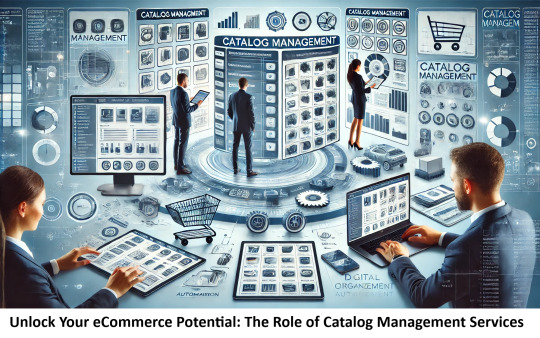
This blog explores how eCommerce catalog management services can unlock your online store's potential and drive business growth.
The Importance of eCommerce Catalog Management
eCommerce catalog management involves structuring, updating, and enhancing the product information that fills your online store. It involves everything from updating product descriptions, images, and prices to managing inventory levels and categorizing products for easy navigation. Effective catalog management is crucial for various reasons:
1. Enhanced User Experience: A well-organized product catalog allows customers to find what they're looking for quickly and easily. This improved user experience leads to higher conversion rates and increased customer satisfaction.
2. Improved SEO Performance: Search engines like Google prioritize websites with well-structured, relevant, and up-to-date content. By regularly updating your product catalog and optimizing it with the right keywords, you can improve your store’s visibility in search engine results pages (SERPs).
3. Increased Operational Efficiency: A streamlined catalog management process reduces errors and saves time, allowing your team to focus on other critical areas of your business.
4. Scalability: As your business expands, your range of products will also increase. Effective catalog management ensures that you can easily scale your online store without sacrificing quality or efficiency.
The Role of Catalog Management Services
Outsourcing catalog management services to experts like EnFuse Solutions India can transform the way your eCommerce business operates.
Here's how these services can help you maximize your potential:
1. eCommerce Product Catalog Optimization: Optimizing your product catalog is key to attracting and retaining customers. Catalog management services focus on refining product titles, descriptions, and metadata to ensure they are not only informative but also search engine friendly. This optimization improves your product rankings in search results, increasing their visibility to potential customers.
2. Catalog Management For Online Stores: Managing a large and diverse product catalog can be overwhelming, especially as your inventory grows. Catalog management services offer solutions that help you categorize products logically, update listings efficiently, and ensure consistency across all platforms. This organized approach enhances the shopping experience and increases customer trust.
3. eCommerce Product Data Management: Accurate and up-to-date product data is critical for both customers and internal operations. Catalog management services ensure that all product information, including pricing, stock levels, and specifications, is consistently maintained. This reduces the risk of errors, such as overselling or providing incorrect information, which can damage your reputation and lead to lost sales.
4. Customized Catalog Management Solutions: Each eCommerce business has its distinct challenges and needs. Catalog management services offer tailored solutions that align with your specific needs. Whether you require advanced analytics, multi-channel integration, or localized content, these services can be customized to support your growth and success.
Why Choose EnFuse Solutions India?
At EnFuse Solutions India, we grasp the complexities of managing eCommerce catalogs. Our team of experts leverages the latest tools and best practices to deliver comprehensive catalog management solutions that drive results. From eCommerce catalog management services to product data management, we provide end-to-end support that empowers your business to thrive in a competitive marketplace.
By partnering with EnFuse Solutions India, you gain access to industry-leading expertise and innovative strategies that can unlock your eCommerce potential. Our commitment to quality, efficiency, and customer satisfaction ensures that your online store not only meets but exceeds expectations.
#eCommerceCatalogManagement#CatalogManagementServices#eCommerceProductCatalogOptimization#CatalogManagementForOnlineStores#eCommerceProductDataManagement#CatalogManagementSolutions#eCommerceCatalogManagementServices#EnFuseSolutionsIndia
0 notes
Text
The Role of AEM in Omnichannel Experience: Unifying Customer Journeys
In today’s dynamic digital landscape, delivering a consistent and personalised customer experience across multiple channels is paramount for businesses. This is where Adobe Experience Manager (AEM) steps in, providing a robust platform to streamline and enhance the customer journey.

Let’s explore how Adobe Experience Manager (AEM) transforms omnichannel marketing and unifies customer journeys for seamless experiences.
AEM Omnichannel Experience: Revolutionizing Customer Interactions
Adobe Experience Manager (AEM) is a comprehensive content management solution designed to manage digital experiences across various touchpoints. AEM Omnichannel Experience allows businesses to deliver personalised content to customers whether they are interacting via mobile, web, social media, or in-store. The capability to manage and optimize content across these channels ensures that customers receive consistent and relevant experiences, fostering brand loyalty and engagement.
Adobe Experience Manager Customer Journey: Enhancing Personalization
Understanding and mapping the customer journey is crucial for effective marketing. Adobe Experience Manager excels in tracking and analyzing customer interactions across different channels. By leveraging AEM for unified customer journeys, businesses can gather valuable insights into customer behaviour, preferences, and needs. This data-driven approach allows creating highly personalized content, tailored to individual customer journeys, thus enhancing customer satisfaction and driving conversions.
AEM for Unified Customer Journeys: Bridging the Gap
A major challenge in omnichannel marketing is dealing with the disjointed nature of customer interactions. AEM for seamless customer journeys bridges this gap by integrating various touchpoints into a cohesive system. This integration ensures that no matter where the customer interacts with the brand, they experience a unified and consistent journey. From the first point of contact to the final purchase, AEM ensures that every interaction is interconnected, providing a holistic view of the customer journey.
Omnichannel Marketing with AEM: Delivering Consistency
Consistency is key in omnichannel marketing. With AEM, businesses can ensure that their messaging, branding, and customer experience remain consistent across all channels. AEM's robust content management capabilities allow marketers to create and distribute content efficiently, ensuring that every customer touchpoint reflects the same quality and message. This consistency not only fosters trust but also strengthens the brand identity in customers' perceptions.
AEM Customer Experience Management: Streamlining Operations
Effective customer experience management is about more than just delivering content; it’s about managing the entire process from creation to delivery. AEM customer experience management provides tools to streamline content creation, approval workflows, and distribution processes. This streamlining reduces operational complexities and ensures that content is delivered promptly and accurately across all channels, enhancing the overall customer experience.
Adobe Experience Manager Omnichannel Solutions: Tailored for Success
Adobe Experience Manager omnichannel solutions are designed to cater to the specific needs of businesses, offering flexibility and scalability. Whether it’s a small business looking to improve its digital presence or a large enterprise aiming for a comprehensive digital transformation, AEM provides tailored solutions that align with business goals. The adaptability of AEM ensures that businesses can effectively manage and optimize their omnichannel strategies, leading to better customer engagement and higher ROI.
Benefits of Using AEM for Seamless Customer Journeys
1. Enhanced Customer Experience: By providing consistent and personalized content across all channels, AEM enhances the overall customer experience. This leads to increased customer satisfaction and stronger loyalty.
2. Increased Efficiency: AEM's centralized content management system streamlines the content creation and distribution process, leading to increased efficiency and reduced operational costs.
3. Better Data Insights: With AEM's analytics and reporting tools, businesses can gain valuable insights into customer behaviour and preferences. This approach, driven by data, enhances targeting accuracy and personalization.
4. Scalability: AEM's flexible architecture allows businesses to scale their content management efforts as they grow. No matter if you're running a small business or managing a large enterprise, AEM is flexible enough to meet your specific needs.
Best AEM Services Providers: EnFuse Solutions India
Selecting the right service provider is essential to fully harness the capabilities of AEM. EnFuse Solutions India is one of the best AEM service providers, offering expert guidance and support in implementing AEM solutions. With a deep understanding of AEM’s capabilities and a commitment to delivering excellence, EnFuse Solutions India helps businesses achieve their digital transformation goals, ensuring that their omnichannel marketing strategies are effective and impactful.
Conclusion
In conclusion, Adobe Experience Manager plays a pivotal role in enhancing omnichannel experiences by unifying customer journeys and ensuring consistent and personalized interactions across all touchpoints. By leveraging AEM for seamless customer journeys, businesses can streamline operations, deliver consistent messaging, and gain valuable insights into customer behaviour. Partnering with top service providers like EnFuse Solutions India ensures businesses can fully harness the power of AEM, driving better customer engagement and achieving higher returns on their digital marketing investments.
Embrace the future of omnichannel marketing with Adobe Experience Manager and transform your customer journeys into seamless, personalized experiences that drive growth and loyalty.
#AEMOmnichannelExperience#AdobeExperienceManagerCustomerJourney#AEMForUnifiedCustomerJourneys#OmnichannelMarketingWithAEM#AEMCustomerExperienceManagement#AdobeExperienceManagerOmnichannelSolutions#AEMForSeamlessCustomerJourneys#BestAEMServiceProviders#EnFuseSolutionsIndia
0 notes
Text
The Psychology of Proctoring: Understanding Student Perceptions and Responses
Online learning and assessments have become the norm in today's rapidly evolving educational landscape. With this shift, online proctoring has emerged as a crucial component to ensure academic integrity. However, the psychological impact of proctoring on students warrants careful consideration. Understanding student perceptions of proctoring, their responses, and the broader psychological effects can help educators and proctoring companies improve their methods and support student well-being.

Student Perceptions of Proctoring
Students' perceptions of proctoring can vary widely. While some view it as a necessary measure to uphold academic integrity, others may see it as an invasion of privacy and a source of significant stress. How proctoring is perceived can greatly influence a student's performance and overall experience during an exam.
Proctoring and Student Anxiety: Anxiety is a common response among students subjected to online proctoring. The presence of a virtual invigilator, combined with the fear of technical issues or being falsely accused of cheating, can heighten stress levels. This anxiety can negatively affect performance, leading to lower scores and a less accurate reflection of a student's true abilities.
Psychological Impact of Proctoring
The psychological impact of proctoring extends beyond anxiety. It can affect a student's mental health and their attitude towards exams and learning.
Student Responses to Online Proctoring: Different students respond differently to online proctoring. Some may become overly cautious, while others might develop a sense of defiance or distrust towards the system. Understanding these responses can help educators tailor their approach to proctoring, creating a more supportive and less intimidating environment.
Proctoring Effectiveness and Student Behavior: The effectiveness of proctoring in deterring dishonest behaviour can also impact student behaviour. When students believe that proctoring measures are fair and effective, they are more likely to engage honestly with their assessments. Conversely, if proctoring is perceived as overly intrusive or ineffective, students may resort to cheating, believing that the system is flawed.
Proctoring and Academic Integrity
One of the main objectives of proctoring is to preserve academic honesty. However, its implementation must be balanced with considerations for student well-being.
Online Exam Proctoring Psychology: The psychology behind online exam proctoring involves understanding how surveillance affects student behaviour and attitudes. Proctoring can create a high-stakes environment, which might lead to increased pressure and reduced performance. Therefore, it is essential to implement proctoring methods that are transparent, fair, and considerate of students' mental health.
Choosing the Best Proctoring Companies
Selecting the right proctoring company can make a significant difference in how proctoring is perceived and experienced by students. Companies like EnFuse Solutions India are at the forefront of providing reliable and student-friendly proctoring services.
Best Proctoring Companies: The best proctoring companies prioritize both security and student comfort. They offer robust systems that ensure academic integrity without compromising student privacy and mental well-being. EnFuse Solutions India, for instance, uses advanced technologies to create a seamless and non-intrusive proctoring experience, addressing both the technical and psychological needs of students.
Conclusion
Understanding the psychology of proctoring is crucial in creating a balanced and effective online assessment environment. By considering student perceptions, the psychological impact, and their responses to proctoring, educators and proctoring companies can develop strategies that uphold academic integrity while supporting student well-being. Companies like EnFuse Solutions India lead the way in providing proctoring solutions that are both secure and considerate of students' needs, paving the way for a more positive and effective online learning experience.
By addressing these factors and continually improving proctoring methods, we can ensure that online assessments are fair, effective, and supportive of all students.
#StudentPerceptionsOfProctoring#PsychologicalImpactOfProctoring#ProctoringAndStudentAnxiety#StudentResponsesToOnlineProctoring#ProctoringEffectivenessAndStudentBehavior#ProctoringAndAcademicIntegrity#OnlineExamProctoringPsychology#BestProctoringCompanies#EnFuseSolutionsIndia
0 notes
Text
Demystifying AI and ML: How Enablement Services Drive Business Transformation
In the ever-evolving digital landscape, businesses constantly seek innovative solutions to stay ahead. One such groundbreaking advancement is the integration of Artificial Intelligence (AI) and Machine Learning (ML). AI ML enablement services have emerged as a pivotal force, driving substantial business transformation and fostering digital innovation.
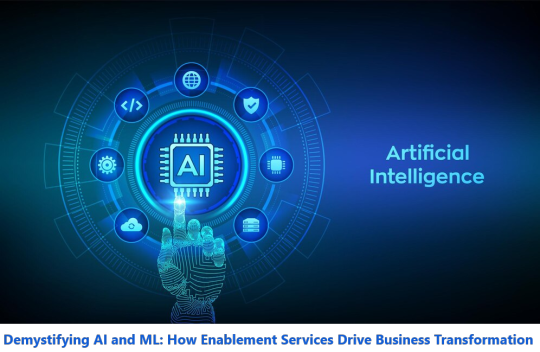
In this blog, we will demystify AI and ML, explore their implementation strategies, and discuss how enablement services are pivotal for business transformation.
The Power of AI ML Enablement Services
AI ML enablement services offer various solutions aimed at incorporating AI and ML technologies into business operations. These services facilitate the seamless adoption of advanced technologies, enabling businesses to harness the power of data and intelligent algorithms. With AI and ML, enterprises can automate routine tasks, enhance decision-making, and unlock new growth opportunities.
Business Transformation With AI
The transformative potential of AI for enterprises cannot be overstated. By utilizing AI business transformation services, companies can enhance operational efficiency, elevate customer experiences, and foster innovation. AI ML enablement services help in identifying key areas where AI can be integrated, ensuring a strategic approach to digital transformation.
AI ML Implementation Strategies
Implementing AI and ML requires a well-thought-out strategy. Successful AI ML implementation strategies involve:
1. Define Clear Objectives: Identify specific business problems or opportunities that AI and ML can address.
2. Data Management: Ensuring the availability of high-quality data, as data is the backbone of AI and ML models.
3. Select the Right Tools and Technologies: Choose AI and ML frameworks and tools that match your goals.
4. Integration and Testing: Seamlessly integrating AI solutions into existing systems and rigorously testing them to ensure efficiency.
5. Pilot Projects: Start with pilot projects to test the feasibility and impact of AI solutions.
6. Scalability: Plan for scalability to ensure the solution can expand alongside your business growth.
7. Continuous Monitoring and Improvement: Regularly monitoring the performance of AI solutions and making necessary adjustments to optimize outcomes.
AI Enablement For Enterprises
AI enablement for enterprises involves equipping businesses with the tools and expertise needed to adopt AI technologies. EnFuse Solutions India excels in providing comprehensive AI ML enablement services, guiding enterprises through every step of the AI integration process. Their expertise ensures that businesses can leverage AI to its full potential, driving significant improvements in productivity and innovation.
ML Solutions For Business
Machine Learning (ML) solutions for business are a critical component of AI ML enablement services. ML algorithms analyze vast amounts of data to uncover patterns and insights that can inform strategic decisions. Businesses can use ML solutions for predictive analytics, customer segmentation, fraud detection, and much more. The application of ML solutions helps businesses stay competitive and agile in a rapidly changing market.
AI-Driven Business Innovation
AI-fueled business innovation is central to contemporary enterprise strategies. By adopting AI ML enablement services, companies can foster a culture of innovation. AI enables the development of new products and services, enhances customer interactions, and opens up new revenue streams. The agility and creativity fostered by AI-driven innovation are crucial for long-term success.
AI ML Digital Transformation
Digital transformation with AI ML is not just a trend; it is a necessity for businesses aiming to thrive in the digital age. AI ML digital transformation involves integrating intelligent technologies into every aspect of business operations. From automating mundane tasks to making data-driven decisions, AI ML solutions transform how businesses operate and compete.
EnFuse Solutions India: Pioneering AI ML Enablement Services
EnFuse Solutions India stands out as a leader in providing AI ML enablement services. Their team of experts offers end-to-end solutions, ensuring businesses can seamlessly transition to AI-driven operations. With a focus on delivering customized solutions, EnFuse Solutions India helps enterprises unlock the full potential of AI and ML, driving impactful business transformation.
Conclusion
In conclusion, AI ML enablement services are revolutionizing the business landscape. By adopting strategic AI ML implementation strategies, enterprises can achieve significant business transformation with AI. Companies like EnFuse Solutions India are at the forefront of this revolution, providing the expertise and support needed to navigate the complexities of AI integration. Embrace AI and ML solutions today and drive your business towards a future of innovation and success.
#AI ML Enablement Services#AI ML Implementation Strategies#AI Enablement For Enterprises#ML Solutions For Business#AI Business Transformation Services#AI ML Digital Transformation#EnFuse Solutions#EnFuse Solutions India
0 notes
Text
The Future of Content Management: Exploring AEM's AI and Machine Learning
As the digital landscape evolves, content management systems (CMS) must adapt to new challenges and opportunities. Adobe Experience Manager (AEM) has consistently been at the forefront of this evolution, and with the integration of artificial intelligence (AI) and machine learning (ML), it is redefining the future of content management.
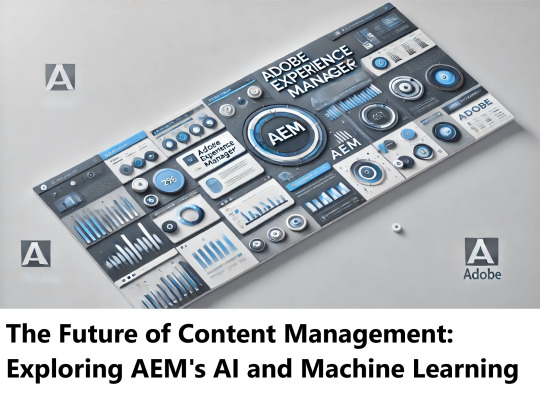
This blog explores the cutting-edge features of AEM powered by AI and ML, and how they are set to transform content management.
AEM AI Content Management: The Next Frontier
AI in Adobe Experience Manager is not just an added feature but a fundamental shift towards smarter, more efficient content management. AEM AI content management leverages advanced algorithms to automate and enhance various aspects of the CMS, from content creation to delivery.
AEM Machine Learning Features: Driving Efficiency
Machine learning in AEM brings a host of features that streamline content workflows. One of the standout features is AEM AI-powered workflows, which automate repetitive tasks such as tagging, categorization, and metadata generation. This approach saves time while maintaining consistency and accuracy, enabling content teams to concentrate on strategic initiatives.
AEM Predictive Content Personalization
AEM's predictive content personalization revolutionizes the way marketers engage with their audience. By examining user behavior and preferences, AEM can provide customized content instantly. This level of personalization enhances user engagement and conversion rates, providing a significant competitive advantage.
AEM AI-Driven Insights for Better Decision-Making
AEM AI-driven insights empower businesses with data-driven decision-making capabilities. By analyzing vast amounts of data, AEM can provide actionable insights into content performance, audience behavior, and market trends. This allows businesses to optimize their content strategies and stay ahead of the curve.
Next-Gen Content Management With AEM
The future of AEM content management lies in its ability to integrate AI and ML seamlessly into its ecosystem. This next-gen content management approach ensures that businesses can manage and deliver content more efficiently and effectively than ever before.
Best AEM Services: Why Choose EnFuse Solutions
To fully leverage the power of AEM AI content management and machine learning features, partnering with an expert like EnFuse Solutions is crucial. EnFuse Solutions offers best-in-class AEM services, including implementation, customization, and ongoing support. Their expertise ensures that businesses can maximize the benefits of AEM's advanced capabilities.
Comprehensive AEM Services by EnFuse Solutions
EnFuse Solutions offers a wide range of services tailored to enable businesses to fully harness the capabilities of AEM. Their services include:
AEM Implementation: Seamless integration of AEM into existing systems.
Customization: Tailoring AEM to meet specific business needs.
Support and Maintenance: Ongoing support to ensure optimal performance.
Training and Consulting: Empowering teams to make the most of AEM's features.
Conclusion
The integration of AI and machine learning in Adobe Experience Manager is set to revolutionize the future of content management. From predictive content personalization to AI-driven insights, AEM is empowering businesses to deliver more engaging, personalized, and effective content. By partnering with experts like EnFuse Solutions, businesses can ensure they are at the forefront of this exciting transformation, fully leveraging AEM's AI-powered workflows and advanced capabilities.
As we look ahead, the future of content management is undeniably bright, with AEM leading the way in innovation and efficiency. Embrace the future with AEM's AI and machine learning features, and unlock new possibilities for your content strategy.
For businesses seeking to stay ahead in the digital age, adopting AEM's AI-driven content management solutions is a strategic imperative. With the expertise of EnFuse Solutions, you can transform your content management approach, driving better results and achieving your business goals more efficiently.
#AEM AI Content Management#AEM Machine Learning Features#Future Of AEM Content Management#AI In Adobe Experience Manager#AEM Predictive Content Personalization#AEM AI Driven Insights#Machine Learning In AEM#AEM AI Powered Workflows#Next Gen Content Management With AEM#Best AEM Services#EnFuse Solutions
0 notes
Text
AEM and AI: Leveraging Artificial Intelligence for Automated Personalization
In today's digital age, delivering personalized content is essential for engaging users and driving conversions. Adobe Experience Manager (AEM), a powerful content management solution, has revolutionised the way businesses manage and deliver digital experiences. With the integration of artificial intelligence (AI), AEM is taking personalization to the next level.

This blog explores how Adobe Experience Manager (AEM) and AI work together to create automated, personalized experiences that captivate audiences and boost business outcomes.
The Power of AEM Artificial Intelligence
AEM Artificial Intelligence enables businesses to harness the power of AI to deliver personalized content seamlessly. By leveraging AI-driven AEM personalization, companies can analyze user behaviour, preferences, and interactions to provide tailored experiences. This not only improves user engagement but also boosts the chances of conversion.
AI-Driven AEM Personalization
AI-driven AEM personalization involves using machine learning algorithms to analyze vast amounts of data and predict user preferences. This allows businesses to deliver content that resonates with individual users, creating a more meaningful and engaging experience. By integrating AI with AEM, companies can automate the personalization process, ensuring that users receive relevant content without manual intervention.
AEM Automated Personalization
Automated personalization with AEM AI streamlines the process of delivering personalized content. Instead of relying on manual segmentation and targeting, AEM uses AI to dynamically adjust content based on user behaviour. This real-time personalization ensures that users receive the most relevant information at the right time, enhancing their overall experience.
AI Personalization in AEM
AI personalization in AEM involves the use of intelligent algorithms to analyze user data and deliver customized content. This can include personalized recommendations, targeted promotions, and tailored messaging. By leveraging AI, AEM can continuously learn and adapt to user preferences, providing an ever-improving personalized experience.
AEM and Machine Learning
Machine learning is at the core of AI-driven AEM personalization. AEM and machine learning work together to analyze user data, identify patterns, and make predictions. This enables businesses to deliver content that aligns with user interests and behaviours. By utilizing machine learning, AEM can provide more accurate and effective personalization, leading to higher user satisfaction and increased conversions.
Intelligent AEM Content
Intelligent AEM content refers to content that AI dynamically generates and customizes based on user data. This includes everything from personalized product recommendations to targeted content based on user interests. By using AI, AEM can deliver content that is highly relevant and engaging, increasing the likelihood of user interaction and conversion.
AI AEM Integration
Integrating AI with AEM allows businesses to leverage the full potential of both technologies. AI AEM integration involves combining the content management capabilities of AEM with the predictive power of AI. This integration allows companies to provide customized content efficiently, ensuring a uniform and compelling experience across all interaction points.
Personalization with AEM AI
Personalization with AEM AI is a game-changer for businesses looking to enhance user experiences. With the aid of AI, AEM can process user data swiftly and deliver personalized content instantaneously. This not only improves user engagement but also increases the effectiveness of marketing campaigns, leading to higher conversion rates and improved business outcomes.
Automated AEM Experiences
Automated AEM experiences involve personalization through AI. This involves using AI to analyze user data and deliver content that is tailored to individual preferences. By automating the personalization process, businesses can ensure that users receive relevant content without manual intervention, improving the overall user experience.
AEM AI Solutions
AEM AI solutions provide businesses with the tools they need to deliver personalized content at scale. These solutions include everything from AI-driven personalization to automated content delivery. By leveraging AEM AI solutions, businesses can enhance user experiences, increase engagement, and drive conversions.
EnFuse Solutions India: Leading the Way in AEM AI Integration
EnFuse Solutions India is at the forefront of AEM AI integration, providing businesses with the expertise and tools they need to deliver personalized content. With a deep understanding of both AEM and AI, EnFuse Solutions India helps businesses harness the power of AI-driven AEM solutions to enhance user experiences and drive business success.
Conclusion
In conclusion, the integration of AEM and AI is transforming the way businesses deliver personalized content. By leveraging AI-driven AEM personalization, companies can create automated, engaging, and effective experiences that captivate users and drive conversions. As a leader in AEM AI integration, EnFuse Solutions India is helping businesses stay ahead of the curve and achieve their digital experience goals.
#AEMArtificialIntelligence#AIDrivenAEMPersonalization#AEMAutomatedPersonalization#AIPersonalizationInAEM#AEMAndMachineLearning#IntelligentAEMContent#AIAEMIntegration#PersonalizationWithAEM AI#AutomatedAEMExperiences#AEMAISolutions#AEMSolutions#EnFuseSolutionsIndia
0 notes
Text
The Impact of Product Data Management on Supply Chain Optimization
In today's ever-changing business environment, efficient supply chain management is essential for staying competitive. A key component in achieving this efficiency is Product Data Management (PDM). By leveraging PDM, businesses can streamline operations, reduce costs, and enhance overall supply chain performance.
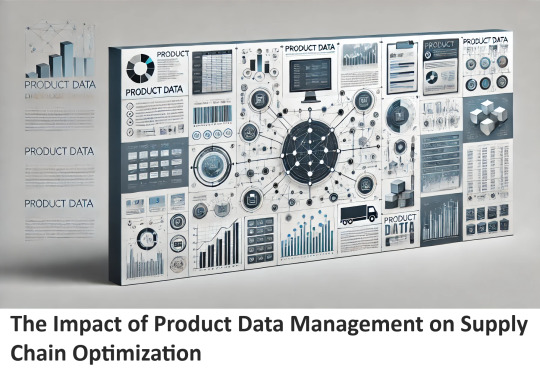
This blog explores the profound impact of Product Data Management on supply chain optimization and highlights strategies for maximizing these benefits.
Product Data Management Benefits
Effective product data management involves organizing, storing, and maintaining accurate product information across the supply chain. This ensures that all stakeholders, from manufacturers to retailers, can access up-to-date and consistent product data. The benefits of PDM are multifaceted:
1. Enhanced Data Accuracy: Accurate product data reduces errors in inventory management, order processing, and customer interactions, improving operational efficiency.
2. Improved Decision-Making: With reliable data, supply chain managers can make informed decisions, from forecasting demand to managing stock levels.
3. Increased Efficiency: Streamlined data management processes minimize redundancies and manual data entry, saving time and resources.
4. Better Customer Experience: Consistent and accurate product information enhances customer satisfaction, as they receive the right products at the right time.
Supply Chain Optimization Strategies
To fully leverage the benefits of PDM, businesses must adopt effective supply chain optimization strategies. These strategies emphasize incorporating PDM into different aspects of the supply chain:
1. Data-Driven Supply Chain: By utilizing data analytics, companies can understand demand trends, stock quantities, and supplier effectiveness. This approach, driven by data, facilitates proactive decision-making and the efficient allocation of resources.
2. Product Information Management (PIM): PIM systems centralize product data to maintain consistency across every channel. This not only improves internal operations but also supports seamless omnichannel experiences for customers.
3. Inventory Management Solutions: Integrating PDM with inventory management systems helps maintain optimal stock levels, reduce carrying costs, and prevent stockouts or overstock situations.
4. Data Integration in Supply Chain: Seamless integration of PDM with other supply chain systems, such as ERP and CRM, ensures a holistic view of operations. This integration enhances collaboration among different departments and improves overall supply chain visibility.
PDM in Supply Chain Management
Product data management plays a pivotal role in supply chain management. By maintaining accurate and consistent product information, businesses can optimize various aspects of their supply chain operations:
1. Efficient Procurement: With reliable product data, procurement teams can source materials more effectively, negotiate better terms, and reduce lead times.
2. Streamlined Production: Accurate product data ensures that production teams have the right information to manufacture products efficiently, minimizing waste and maximizing output.
3. Optimized Logistics: PDM supports efficient logistics planning by providing accurate dimensions, weights, and handling instructions for products. This leads to more economical transportation and decreased shipping mistakes.
Product Data Management Services by EnFuse Solutions India
EnFuse Solutions India leads in delivering advanced product data management services. Their expertise in PDM enables businesses to streamline their supply chain operations, improve data accuracy, and enhance overall efficiency. By utilizing the extensive Product Data Management (PDM) services offered by EnFuse Solutions India, companies can accomplish:
1. Data Consistency: Ensuring consistent product data at every touchpoint.
2. Scalability: Adjusting to the changing demands of expanding businesses.
3. Customization: Tailoring PDM solutions to meet specific industry requirements.
Conclusion
In the current competitive marketplace, efficient product data management is essential for optimizing supply chains. The benefits of PDM, from enhanced data accuracy to improved decision-making, are undeniable. By embracing supply chain strategies driven by data and integrating PDM across multiple functions, businesses can attain unmatched efficiency and enhance customer satisfaction. EnFuse Solutions India stands as a trusted partner in this journey, offering top-notch PDM services to drive supply chain success.
Incorporating robust product data management practices is not just a trend but a necessity for businesses aiming to stay ahead in the ever-evolving landscape of supply chain management. Embrace the power of PDM today and witness the transformation in your supply chain operations.
#ProductDataManagementBenefits#SupplyChainOptimizationStrategies#PDMInSupplyChainManagement#DataDrivenSupplyChain#ProductInformationManagement#InventoryManagementSolutions#DataIntegrationInSupplyChain#ProductDataManagementServices#EnFuseSolutionsIndia
0 notes
Text
Proctoring Compliance: Meeting Regulatory Requirements in Online Education
In today's digital age, online education has revolutionized learning accessibility, allowing students worldwide to pursue education remotely. However, this convenience brings the significant challenge of upholding academic integrity through effective proctoring. Proctoring, particularly online proctoring, is pivotal in ensuring that online exams uphold the same standards of fairness and security as traditional in-person exams.

Understanding Online Proctoring Compliance
Online proctoring compliance refers to adhering to regulatory standards and best practices that guarantee the fairness and validity of online exams. Educational institutions must meet stringent requirements to maintain the credibility of their online assessment processes. These regulations encompass various aspects:
1. Regulatory Requirements for Proctoring
Regulatory bodies set stringent guidelines to maintain the credibility and fairness of online exams. These requirements encompass various aspects:
Security Protocols: Implementing strong security protocols to deter cheating and prevent unauthorized access during examinations.
Data Privacy: Ensuring the confidentiality and protection of personal data collected during proctoring sessions.
Accessibility: Providing equitable access to online exams for all students, including those with disabilities.
2. Compliance in Online Exams
Institutions must implement proctoring solutions that comply with local and international standards to authenticate the identity of test-takers and monitor their behavior during exams.
3. Proctoring Standards in Education
Establishing clear proctoring standards ensures consistency and fairness in assessing students' knowledge and skills, regardless of the exam format or subject matter.
4. Secure Online Exam Proctoring
To meet regulatory requirements effectively, institutions rely on advanced proctoring services. These solutions utilize state-of-the-art technologies including:
AI-powered Monitoring: Real-time analysis of exam sessions to detect suspicious behavior and ensure exam integrity.
Biometric Authentication: Verifying the identity of students using facial recognition or fingerprint scanning.
Live Proctoring: Oversight by trained proctors who monitor exams remotely to intervene in case of irregularities.
5. Educational Compliance Solutions
To meet these challenges effectively, educational institutions are turning to specialized proctoring service providers. These providers deliver holistic solutions customized to meet the unique requirements of online education:
Online Test Security Regulations: Ensuring compliance with stringent security regulations is pivotal in safeguarding the authenticity and confidentiality of online exams.
Proctoring Services Accreditation: Choosing accredited proctoring services guarantees adherence to industry standards and regulatory requirements, providing peace of mind to institutions and students alike.
Online Proctoring Services in India: In the context of India's burgeoning online education sector, the demand for reliable proctoring services that comply with local regulations is on the rise. EnFuse Solutions stands out as a leader in providing state-of-the-art proctoring solutions that meet these needs effectively.
Why Choose EnFuse Solutions?
EnFuse Solutions combines technological innovation with a deep understanding of educational compliance needs. Their proctoring services not only ensure regulatory compliance but also enhance the overall exam-taking experience for students:
Accredited Proctoring Services: Ensuring compliance with national and international accreditation standards.
Secure Exam Environment: Implementing encrypted communication channels and secure browser settings to prevent exam breaches.
Data Protection Measures: Protect student information by strictly complying with data privacy laws and regulations.
Customized Solutions: Tailored proctoring solutions cater to diverse educational settings, from universities to professional certification bodies, ensuring seamless integration and minimal disruption.
Comprehensive Support: From initial setup to ongoing support and compliance monitoring, EnFuse Solutions partners with educational institutions to navigate regulatory landscapes effectively.
Embracing the Future of Online Education
As technology continues to evolve, so do the challenges and opportunities in online education. Institutions partnering with EnFuse Solutions not only meet regulatory requirements seamlessly but also enhance the credibility and trustworthiness of their online education offerings. By prioritizing compliance in online proctoring, institutions uphold their commitment to academic integrity and student success in the digital age.
Conclusion
As online education keeps growing worldwide, ensuring proctoring compliance becomes increasingly crucial. Institutions must prioritize regulatory adherence and choose proctoring solutions that uphold the integrity of online exams. With EnFuse Solutions' expertise in online proctoring services, educational institutions can confidently meet regulatory requirements while delivering secure and credible assessments.
In summary, embracing proctoring compliance not only meets regulatory standards but also fosters trust and credibility in online education—a crucial step toward shaping the future of learning. For more information on how EnFuse Solutions India can support your institution's proctoring compliance needs, visit EnFuse Solutions today.
#OnlineProctoringCompliance#RegulatoryRequirementsForProctoring#ComplianceInOnlineExams#ProctoringStandardsEducation#SecureOnlineExamProctoring#EducationalComplianceSolutions#OnlineTestSecurityRegulations#ProctoringServicesAccreditation#OnlineProctoringServicesInIndia#EnFuseSolutions
0 notes
Text
Improving Data Quality: The Role of Data Labeling in AI Development
In the rapidly evolving landscape of artificial intelligence (AI), data quality plays a pivotal role in shaping the accuracy and performance of AI models. One crucial aspect of ensuring high-quality data is effective data labeling. Data labeling is the process of annotating datasets with relevant tags or labels that help AI systems learn and make accurate predictions.

In this blog, we delve into the role of data labeling in AI development and how it contributes to enhancing data quality AI.
The Crucial Role of Data Labeling in AI Development
Data labeling is the backbone of supervised learning, where AI models learn from labeled examples to make predictions on new, unlabeled data. The role of data labeling in AI development cannot be overstated, as it directly influences the quality and reliability of AI models. Accurate and consistent labeling ensures that AI systems can correctly interpret and process data, leading to more precise outcomes.
Enhancing Data Quality for AI
Quality data for AI is the foundation for successful models. Data labeling for AI involves meticulously annotating datasets to eliminate noise and errors, thus improving the overall quality of the data. When data is accurately labeled, AI models can better understand patterns and relationships within the data, resulting in improved performance and reliability. This is particularly important in applications like image recognition, natural language processing, and autonomous driving, where even small errors can have significant consequences.
The Impact of Quality Data on AI Models
The quality of data directly affects the performance of AI models. AI model data quality is critical for achieving accurate predictions and minimizing biases. Poorly labeled data can lead to incorrect training, causing AI systems to make flawed decisions. By investing in quality data labeling, organizations can ensure that their AI models are trained on accurate and representative data, leading to better outcomes and increased trust in AI technologies.
The Process of Data Labeling for AI Development
Data labeling involves several steps to ensure accuracy and consistency. Here are the key stages in the AI development data labeling process:
1. Data Collection: Gathering raw data from various sources is the first step. This data can be in the form of text, images, videos, or audio files.
2. Annotation Guidelines: Establishing clear annotation guidelines is crucial for consistency. These guidelines outline how data should be labeled, ensuring that annotators follow the same criteria.
3. Annotation Tools: Utilizing advanced annotation tools can streamline the labeling process. These tools offer features like automated labeling, collaboration, and quality control mechanisms.
4. Quality Control: Implementing rigorous quality control measures ensures that the labeled data meets the required standards. This can include routine audits, checks for agreement among annotators, and feedback mechanisms.
Data Labeling Solutions and Expertise
Leveraging data labeling solutions and expertise can significantly enhance the efficiency and accuracy of the labeling process. Organizations such as EnFuse Solutions with their data labeling expertise, offer extensive services specifically designed to cater to the distinct requirements of AI development projects. Their expertise in machine learning data labeling ensures that organizations receive high-quality labeled data, enabling them to build robust AI models.
Why Choose EnFuse Solutions?
EnFuse Solutions India stands out as a leader in data labeling, offering a range of services designed to improve data quality for AI development. Their skilled annotators follow stringent quality control measures to deliver precise and consistent labeling. By partnering with EnFuse Solutions, organizations can benefit from their extensive experience and commitment to excellence in data labeling.
Conclusion
Data labeling is crucial for obtaining high-quality data, which in turn leads to precise and dependable AI models. As the demand for AI technologies continues to grow, investing in effective data labeling processes becomes increasingly important. EnFuse Solutions provides top-notch data labeling services that ensure your AI models are trained on the best possible data, leading to superior performance and outcomes.
Enhance your AI development efforts with quality data labeling and experience the difference it makes in your AI initiatives.
#RoleofDataLabeling#AIDevelopmentDataLabeling#DataLabelingforAI#EnhancingDataQualityAI#AIModelDataQuality#MachineLearningDataLabeling#QualityDataforAI#DataLabelingSolutions#DataLabelingExpertise#EnFuseSolutions#EnFuseSolutionsIndia
0 notes